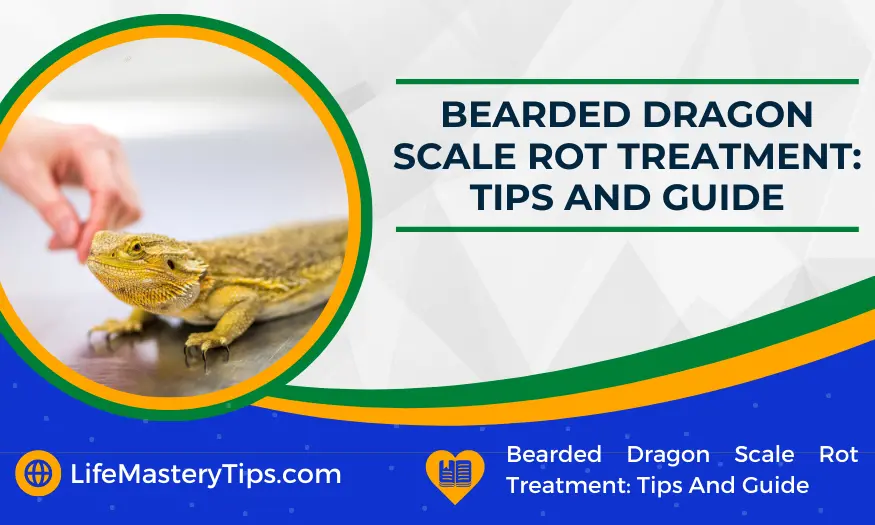How To Trim Bearded Dragon Toes Safely? .Bearded dragons make great pets. Trimming a bearded dragon’s toes can be a delicate and important task, ensuring their overall health and well-being. While it may seem daunting at first, with the right approach and some precautions, you can safely trim their toenails without causing any harm or distress to your scaly friend.
Another Interesting Read: How to Create a Realistic Bearded Dragon Tattoo
If you don’t know how to trim your bearded dragon’s toes safely, then we have the perfect guide for you. Our guide is written by experts who have years of experience taking care of these lizards. You can trust our advice – it will help keep your pet healthy and safe.
How to trim a bearded dragon’s toes safely
Bearded dragons are lizards that are native to Australia. They are popular pets because of their docile nature and ability to be easily trained. One thing that owners must do regularly is trim their beardie’s nails. If not done properly, this can lead to injury for your pet.
Before we delve into the trimming process, it’s crucial to understand the reasons behind why you might need to trim their toenails. Bearded dragons are primarily ground-dwelling creatures, and in their natural habitat, their nails wear down naturally through activities like climbing and digging.
In captivity, their nails may not receive the same wear, and they can become overgrown, leading to discomfort, pain, and potential complications. Trimming their nails regularly is essential to prevent issues such as ingrown nails or even injury from accidentally scratching themselves or their enclosure.
Now, let’s explore the step-by-step process of safely trimming your bearded dragon’s toenails:
1. Gather the necessary supplies:
Nail clippers or baby nail scissors: Choose a tool specifically designed for small animals, as they are safer to use and provide better control.
Styptic powder or cornstarch: This will help stop bleeding in case you accidentally trim the nail too short and nick the quick.
A towel or reptile handling gloves: These will provide a secure grip and minimize the risk of accidentally dropping or injuring your bearded dragon during the process.
2. Create a calm and comfortable environment:
Find a quiet room where you can work without distractions or sudden noises that may startle your bearded dragon.
Prepare a soft surface, such as a towel or a cushion, where your dragon can rest comfortably during the procedure.
3. Familiarize your bearded dragon with handling:
Prior to trimming their nails, spend some time gently handling your bearded dragon to help them get used to being touched on their feet.
Gradually introduce them to the sensation of having their toes gently squeezed to mimic the trimming process.
4. Securely hold your bearded dragon:
Wrap your dragon in a towel or use reptile handling gloves to provide a secure grip.
Ensure that their body and tail are well supported, while leaving one foot exposed for trimming.
5. Identify the quick:
The quick is the pinkish or reddish area within the nail that contains blood vessels and nerves. Trimming into the quick can cause bleeding and discomfort, so it’s essential to identify it before proceeding.
In light-colored nails, the quick is easier to see, while it may be more challenging to identify in darker nails. Take extra caution when trimming dark nails to avoid cutting into the quick.
6. Trim the nails:
Take the nail clippers or baby nail scissors and hold them at a slight angle, avoiding a straight cut that may crush the nail.
Carefully trim a small portion of the nail, avoiding the quick. It’s better to trim a little at a time to ensure you don’t accidentally cut too far.
If you’re uncertain about the position of the quick, it’s safer to trim less rather than risk cutting too deeply.
Focus on trimming the pointed tip of the nail to reduce the likelihood of accidental scratching.
7. Monitor for signs of stress or discomfort:
Watch your bearded dragon closely during the trimming process. If they show signs of stress, such as hissing, puffing up, or attempting to escape, take a break and allow them to calm down before continuing.
If your bearded dragon becomes excessively agitated or appears to be in distress, consider seeking professional help from a reptile veterinarian.
8. Apply styptic powder or cornstarch (if necessary):
If you accidentally cut into the quick and cause bleeding, remain calm and apply styptic powder or cornstarch to the affected area.
Use a small amount of powder and gently press it onto the bleeding nail to promote clotting. Apply a bit of pressure and hold it for a few seconds until the bleeding stops.
9. Offer positive reinforcement:
After the trimming session, reward your bearded dragon with a treat or a favorite food to create a positive association with the experience.
Praising them with gentle words and soft strokes will help them relax and feel more comfortable during future nail trims.
Remember, patience and a gentle touch are key when trimming your bearded dragon’s toenails. If you’re unsure or uncomfortable performing this task yourself, it’s always wise to consult a reptile veterinarian or an experienced reptile groomer who can assist you or provide guidance. Regularly monitoring your bearded dragon’s nails and maintaining their overall health will contribute to their well-being and ensure that they can walk and climb comfortably without any issues.
The benefits of trimming a bearded dragon’s toes
The benefits of trimming a bearded dragon’s toes are numerous.
#1 – It can help to prevent injuries.
If the nails are too long, they can catch on things and rip off, which can be extremely painful for your bearded dragon.
#2 – It can help to improve their mobility.
Long nails can make it difficult for bearded dragons to walk and climb, so trimming them can help your dragon get around more easily.
#3 – It can help to prevent infection.
If the nails are too long, they can harbor bacteria and other organisms that can cause infections.
#4 – It can help to improve their appearance.
Long nails can make a bearded dragon look unkempt, so trimming them can help your dragon look its best.
#5 – It can be a bonding experience for you and your dragon.
Trimming your bearded dragon’s nails can be a great way to spend some quality time together, and it can help you bond with your pet.
Tips for trimming a bearded dragon’s toes safely
These tips will help you trim your bearded dragon’s nails quickly and efficiently, with minimal stress to both you and your pet.
#1 – Get everything you need before you start
Before you even think about trimming your bearded dragon’s nails, gather all of the supplies you’ll need. This includes:
- A reptile nail trimmer (you can find these at most pet stores)
- A styptic powder or pen (to stop any bleeding in case you cut the nail
#2 – Have your bearded dragon sit on your lap
This will help to keep them calm and still while you trim their nails. If they’re wiggling around, it’ll be much harder to trim their nails safely.
#3 – Only trim a little bit at a time
If you try to trim too much off at once, you risk cutting the quick (the blood vessel inside the nail). This will not only hurt your bearded dragon, but it will also cause them to bleed.
#4 – Apply pressure to the toe after trimming
After you’ve trimmed the nail, apply pressure to the toe with a cotton ball or piece of gauze. This will help to stop any bleeding.
#5 – Reward your bearded dragon
After you’re done trimming their nails, be sure to give your bearded dragon a treat! This will help them to associate nail trimming with something positive, making it an easier experience for both of you next time.
#6 – Check their nails regularly
It’s important to keep an eye on your bearded dragon’s nails and trim them regularly. This will help to keep their nails healthy and prevent any problems in the future.
How to prevent infection after trimming a bearded dragon’s toes
There are a few things you can do to prevent infection after trimming your bearded dragon’s toes.
#1 – Use a clean, sharp knife.
A clean, sharp knife is the best way to prevent infection after trimming your bearded dragon’s toes. If the knife is dull or dirty, it can cause bacteria to enter the wound and cause an infection.
#2 – Clean the wound immediately after trimming.
After you have trimmed your bearded dragon’s toes, it is important to clean the wound immediately. This will help to remove any bacteria that may be on the skin. You can use mild soap and water to clean the wound.
#3 – Apply a topical antibiotic.
After you have cleaned the wound, you should apply a topical antibiotic ointment to the area. This will help to prevent infection.
#4 – Keep the wound clean and dry.
It is important to keep the wound clean and dry. This means that you should avoid putting any creams or ointments on the area. You should also avoid getting the area wet.
#5 – Monitor the wound for signs of infection.
If you notice any redness, swelling, or discharge from the wound, it may be a sign of infection. If you notice any of these signs, you should contact your veterinarian immediately.
What to do if there is an infection after trimming a bearded dragon’s toes
If you notice any redness, swelling, or discharge from the toe after trimming, this may be a sign of infection. Soak the toe in warm water for 10 minutes, then apply an antibiotic ointment. If the infection does not improve within a few days, or if it appears to be getting worse, make an appointment with your vet.
Conclusion – How To Trim Bearded Dragon Toes Safely
So, there you have it! The complete guide on how to trim bearded dragon toes safely. If you’re feeling nervous about giving your dragon a pedicure, remember that practice makes perfect. Start with just one or two nails and work up to the whole foot as your lizard gets more comfortable with the process. Soon enough, both of you will be pros at toe trimming!
You Might Also Like:




